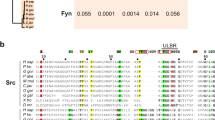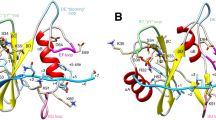Abstract
The catalytic activity of Src family tyrosine kinases is inhibited by intramolecular interactions between the regulatory SH3 and SH2 domains and the catalytic domain. In the inactive state, the critical αC-helix in the catalytic domain is positioned such that the formation of the Glu 310–Lys 295 salt bridge is precluded, Tyr 416 in the activation loop is unphosphorylated, and the SH2 and SH3 domains are unavailable for interactions with other proteins. We found that phosphorylation of the activation loop or mutation of the loop preceding the αC-helix activates Src and increases the accessibility of the SH3 domain for ligands. Interaction of the αC-helix with the activation loop is a central component of this regulatory system. Our data suggest a bidirectional regulation mechanism in which the regulatory domains inhibit Src activity, and Src activity controls the availability of the regulatory domains. By this mechanism, Src family kinases can be activated by proteins phosphorylating or changing the conformation of the catalytic domain. Once active, Src family kinases become less prone to regulation, implying a positive feedback loop on their activity.
This is a preview of subscription content, access via your institution
Access options
Subscribe to this journal
Receive 12 print issues and online access
$189.00 per year
only $15.75 per issue
Buy this article
- Purchase on Springer Link
- Instant access to full article PDF
Prices may be subject to local taxes which are calculated during checkout





Similar content being viewed by others
References
Brown, M.T. & Cooper, J.A. Biochim. Biophys. Acta 1287, 121–149 (1996).
Thomas, S.M. & Brugge, J.S. Annu. Rev. Cell. Dev. Biol. 13, 513–609 (1997).
Hubbard, S.R. Nature Struct. Biol. 6, 711–714 (1999).
Erpel, T. & Courtneidge, S.A. Curr. Biology 7, 176–182 (1995).
Kaplan, K.B. et al. EMBO J. 13, 4745–4756 (1994).
Schwartzberg, P.L. et al. Genes Dev. 11, 2835–2844 (1997).
Kaplan, K.B., Swedlow, J.R., Morgan, D.O. & Varmus, H.E. Genes Dev. 9, 1505–1517 (1995).
Fincham, V.J. & Frame, M.C. EMBO J. 17, 81–92 (1998).
Felsenfeld, D.P., Schwartzberg, P.L., Venegas, A., Tse, R. & Sheetz, M.P. Nature Cell. Biol. 1, 200–206 (1999).
Sicheri, F. & Kuriyan, J. Curr. Opin. Struct. Biol. 7, 777–785 (1997).
Williams, J.C., Wierenga, R.K. & Saraste, M. Trends Biochem Sci 23, 179–184 (1998).
Xu, W., Harrison, S.C. & Eck, M.J. Nature 385, 595–602 (1997).
Sicheri, F., Moarefi, I. & Kuriyan, J. Nature 385, 602–609 (1997).
Williams, J.C. et al. J. Mol. Biol. 274, 757–775 (1997).
Xu, W., Doshi, A., Lei, M., Eck, M.J. & Harrison, S.C. Mol.Cell 3, 629–638 (1999).
Schindler, T. et al. Mol. Cell 3, 639–648 (1999).
Erpel, T., Superti-Furga, G. & Courtneidge, S.A. EMBO J. 14, 963–975 (1995).
Gonfloni, S. et al. EMBO J. 16, 7261–7271 (1997).
Gonfloni, S., Frischknecht, F., Way, M. & Superti-Furga, G. Nature Struct. Biol. 6, 760–764 (1999).
Wright, D.D., Sefton, B.M. & Kamps, M.P. Mol. Cell Biol. 14, 2429–2437 (1994).
Moarefi, I. et al. Nature 385, 650–653 (1997).
Briggs, S.D., Sharkey, M., Stevenson, M. & Smithgall, T.E. J. Biol. Chem. 272, 17899–17902 (1997).
Hartley, D.A. et al. J. Biol. Chem. 274, 20056–20059 (1999).
LaFevre-Bernt, M. et al. J. Biol. Chem. 273, 32129–32134 (1998).
Weijland, A. et al. Proc. Natl. Acad. Sci. USA 94, 3590–3595 (1997).
Koegl, M., Courtneidge, S.A. & Superti-Furga, G. Oncogene 11, 2317–2329 (1995).
Iba, H., Takeya, T., Cross, F.R., Hanafusa, T. & Hanafusa, H. Proc. Natl. Acad. Sci. USA 81, 4424–4428 (1984).
Levy, J.B., Iba, H. & Hanafusa, H. Proc. Natl. Acad. Sci. USA 83, 4228–4232 (1986).
Ferracini, R. & Brugge, J. Oncogene Res. 5, 205–219 (1990).
Sudol, M. et al. Nucl. Acids Res. 16, 9876 (1988).
Sun, G., Sharma, A.K. & Budde, R.J. Oncogene 17, 1587–1595 (1998).
Hardwick, J.S. & Sefton, B.M. J. Biol. Chem. 272, 25429–25432 (1997).
Superti-Furga, G., Fumagalli, S., Koegl, M., Courtneidge, S.A. & Draetta, G. EMBO J. 12, 2625–2634 (1993).
Kypta, R.M., Goldberg, Y., Ulug, E.T. & Courtneidge, S.A. Cell 62, 481–492 (1990).
Nicholls, A., Sharp, K.A. & Honig, B. Proteins 11, 281–296 (1991).
Acknowledgements
We wish to thank R. Wierenga for support, H. Pluk for the HA-paxillin construct, M.J. Eck for the human Src coordinates, T. Erpel and S.A. Courtneidge for the original SH3 domain swap and suggestions, A. Nelsbach for the anti-phospho-Y416 antibodies, J.R. Engen for help with the figures, A. Nebreda, R. Klein, M. Way and members of the Superti-Furga laboratory for suggestions and critical reading of the manuscript. S.G. was supported by a fellowship from the EC, the EMBL and the Boncompagni-Ludovisi Foundation. A.W. was supported by an EC fellowship.
Author information
Authors and Affiliations
Corresponding author
Rights and permissions
About this article
Cite this article
Gonfloni, S., Weijland, A., Kretzschmar, J. et al. Crosstalk between the catalytic and regulatory domains allows bidirectional regulation of Src. Nat Struct Mol Biol 7, 281–286 (2000). https://doi.org/10.1038/74041
Received:
Accepted:
Issue Date:
DOI: https://doi.org/10.1038/74041
This article is cited by
-
Advances in the expression and function of Fyn in different human tumors
Clinical and Translational Oncology (2023)
-
Survey of solution dynamics in Src kinase reveals allosteric cross talk between the ligand binding and regulatory sites
Nature Communications (2017)
-
Simultaneous deactivation of FAK and Src improves the pathology of hypertrophic scar
Scientific Reports (2016)
-
Loss of CAR promotes migration and proliferation of HaCaT cells and accelerates wound healing in rats via Src-p38 MAPK pathway
Scientific Reports (2016)
-
Coordinating ERK/MAPK signalling through scaffolds and inhibitors
Nature Reviews Molecular Cell Biology (2005)



